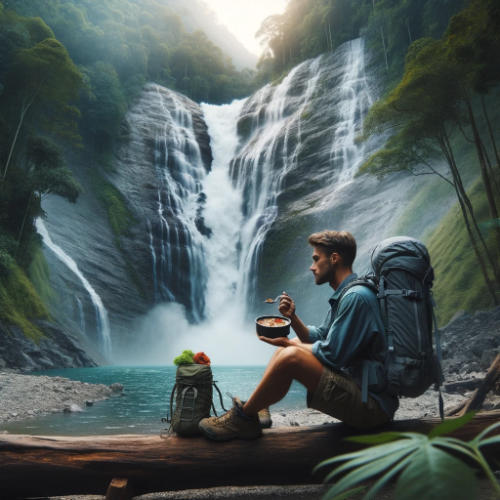
Freeze-Dried Meals for Backpacking are revolutionizing the way backpackers eat on the trail. Offering a perfect blend of convenience, nutrition, and lightness, these meals have become essential for outdoor enthusiasts. This article delves into the world of freeze-dried foods, examining their benefits, variety, and preparation methods. Whether you’re a seasoned hiker or a novice, understanding the role of freeze-dried meals can transform your backpacking experience, making every adventure more enjoyable and hassle-free.
Understanding Freeze-Dried Meals
Freeze-dried meals have become a cornerstone of modern backpacking, offering an ideal solution for nourishing adventurers on their journeys. At the core of these meals lies the freeze-drying process, a technique that removes moisture from food while preserving its flavor, texture, and nutritional value.
The process of freeze-drying involves first freezing the food and then placing it in a vacuum, allowing the frozen water in the food to sublimate directly from ice to vapor. This method retains the food’s cellular structure, resulting in a product that is remarkably similar in taste and nutrition to its fresh counterpart. Unlike traditional dehydration, which can lead to a loss of essential nutrients and a change in flavor and texture, freeze-drying maintains much of the food’s original qualities. This preservation method not only ensures a longer shelf life but also keeps the food lightweight and compact, which is crucial for backpacking.
Nutritionally, freeze-dried meals are superior to many other forms of trail food. They retain a high percentage of the original food’s vitamins and minerals, a vital aspect for backpackers who need to maintain their energy and health on strenuous treks. The removal of moisture also inhibits the growth of microorganisms and enzymes that would otherwise spoil the food. As a result, freeze-dried meals can last for years without refrigeration, making them an ideal choice for long backpacking trips where access to fresh food is limited.

Benefits of Freeze-Dried Meals for Backpacking
The use of freeze-dried meals for backpacking offers several significant benefits that cater to the unique needs of outdoor adventurers. These benefits address key concerns such as weight, nutrition, convenience, and variety, making freeze-dried meals an increasingly popular choice among backpackers.
One of the primary advantages of freeze-dried meals is their lightweight and compact nature. The freeze-drying process effectively removes most of the food’s water content, resulting in a product that is significantly lighter and less bulky than its original form. This weight reduction is crucial for backpackers who must carry all their supplies, as it minimizes the load on their backs, allowing for more comfortable and longer treks.
In terms of shelf life, freeze-dried meals excel. Removing moisture prevents the growth of bacteria and mold, enabling these meals to last for years without refrigeration. This long shelf life is particularly beneficial for backpackers who plan extended trips or want to store emergency provisions without the worry of spoilage.
Another key benefit is the ease of preparation. Freeze-dried meals are designed for simplicity; usually, they only require the addition of hot water to rehydrate and become ready to eat. This convenience is a significant advantage in the wilderness, where cooking facilities are limited and conserving fuel is essential. The quick and easy preparation process saves time and effort, allowing backpackers to focus on their adventure rather than food preparation.
Additionally, freeze-dried meals offer a wide variety of options, catering to different tastes and dietary requirements. From traditional dishes to international cuisine, the range available ensures that backpackers can enjoy a diverse and enjoyable diet while on the trail. This variety is important not only for taste but also for maintaining a balanced diet, which is essential for the physical demands of backpacking.
Choosing the Right Freeze-Dried Meals for Backpacking
When selecting freeze-dried meals for backpacking, there are several key factors to consider to ensure that the meals meet your specific needs and preferences. Understanding these factors is crucial in making an informed choice that enhances your backpacking experience.
Firstly, personal taste plays a significant role in the selection of freeze-dried meals. Since you will rely on these meals for energy and comfort during your trek, it’s important to choose flavors and types of cuisine that you find enjoyable. The wide variety of options available in the market means there’s likely something to suit everyone’s palate, from classic comfort foods to more exotic dishes.
Dietary needs are another crucial consideration. Many backpackers have specific dietary requirements, such as gluten-free, vegetarian, or high-protein diets. Thankfully, the freeze-dried meal industry has adapted to these needs, offering a range of options to cater to various dietary restrictions. It’s important to read labels and ingredient lists carefully to ensure the meals you choose align with your dietary needs.
Caloric intake is also a vital factor. Backpacking is a physically demanding activity, and it’s essential to consume enough calories to maintain your energy levels. Freeze-dried meals come in different calorie counts, so it’s important to select meals that will provide sufficient energy based on the intensity and duration of your hike. It’s often advisable to opt for meals with a higher calorie content than your regular diet to compensate for the increased energy expenditure.
When comparing different brands and types of freeze-dried meals, consider factors such as taste, nutritional content, cooking time, and price. Some brands might offer more gourmet-style options, while others might focus on high-calorie, nutrient-dense meals. Price can vary significantly between brands and meal types, so it’s important to balance cost with quality and your specific requirements.
Budgeting for your meals is another essential aspect of trip planning. Freeze-dried meals are typically more expensive than traditional backpacking food, but their benefits often justify the cost. Planning your meals in advance and buying in bulk can sometimes lead to cost savings. Additionally, consider the cost per meal relative to the convenience, taste, and nutritional value it offers.

DIY Freeze-Dried Meals
Creating your own freeze-dried meals for backpacking is an excellent way to customize your nutrition and flavors according to personal preferences and dietary needs. This process, while intricate, offers a rewarding and cost-effective way to prepare for your backpacking adventures.
To begin with, the primary requirement for freeze-drying at home is a freeze dryer. This specialized equipment is designed to freeze the food and then create a powerful vacuum, which allows the frozen water in the food to sublimate directly from ice to vapor. While investing in a freeze dryer can be costly, it is a one-time investment that pays off in the long run, especially for avid backpackers who regularly require freeze-dried meals.
The process of freeze-drying your meals involves first preparing and cooking your desired meals. This could range from simple dishes like stews and soups to more complex meals. Once the food is cooked, it needs to be spread evenly on the freeze-dryer trays, ensuring that pieces are not too thick or clumped together, as this can impede the drying process.
After the food is properly placed in the freeze-dryer, the machine takes over. The entire process can take anywhere from 20 to 40 hours, depending on the type and quantity of food. The freeze-drying process removes up to 99% of the moisture, preserving the food’s structure, nutrition, and flavor.
Once freeze-dried, the meals need to be stored correctly to maintain their shelf life. Packaging in airtight containers or vacuum-sealed bags is essential to prevent moisture and air from spoiling the food. It’s also advisable to store the packaged meals in a cool, dark place to further extend their shelf life.
The advantage of DIY freeze-dried meals for backpacking is not just cost-saving but also the ability to control ingredients, portions, and flavors. This is particularly beneficial for those with specific dietary restrictions or preferences. Additionally, homemade freeze-dried meals can be a healthier alternative, as they do not require the added preservatives or sodium that are often found in commercially available options.
Preparing Freeze-Dried Meals in the Wilderness
Preparing and enjoying freeze-dried meals while backpacking is a straightforward process, but it does require some knowledge and planning to ensure the best dining experience in the wilderness.
The primary step in preparing freeze-dried meals for backpacking is rehydration. This process typically involves directly adding a specified amount of boiling water to the meal’s package. The amount of water required varies depending on the meal, so it’s crucial to follow the instructions provided on the packaging. After adding water, the package should be sealed and allowed to sit for a specified period, usually between 5 to 15 minutes. This waiting time allows the food to absorb the water fully, rehydrating it back to a state that closely resembles its original texture and flavor.
Managing water resources is a key aspect of this process. Since water is a valuable commodity on the trail, it’s important to accurately measure the required amount to avoid wasting it. Backpackers should plan their water supply not just for drinking but also for meal preparation. In areas where water is scarce, it’s wise to carry a little extra or plan routes where you can refill your water supply.
Enhancing the flavor of freeze-dried meals is often a desire for many backpackers. While these meals are designed to be flavorful and satisfying, personal tastes vary, and some might find them a bit bland after a few days. Simple additions like spices, herbs, or a small packet of olive oil can greatly enhance the taste. Some backpackers also like to mix different meals or add ingredients like nuts, dried fruits, or cheese for variety and additional nutrition.
Proper Storage and Handling
Proper storage and handling of freeze-dried meals for backpacking are critical for maintaining their quality, taste, and nutritional value. The longevity and convenience of these meals largely depend on how well they are preserved before and during the backpacking trip.
One of the foremost aspects of storing freeze-dried meals is understanding their shelf life. Typically, freeze-dried meals can last several years due to the removal of moisture, which inhibits the growth of microorganisms responsible for food spoilage. However, this long shelf life is contingent upon the meals being stored correctly. They should be kept in their original, sealed packaging until ready for use. The packaging is designed to protect the contents from moisture and air, which are the primary factors that could degrade the meals over time.
For extended storage, the environment in which freeze-dried meals are kept plays a significant role. They should be stored in a cool, dry place to prevent any potential moisture buildup and to maintain their quality. Exposure to extreme temperatures, either hot or cold, can affect the texture and flavor of the meals. Therefore, avoiding places like a car trunk or a damp basement for storage is advisable.
Handling freeze-dried meals also requires some care. Once the package is opened, the contents should be used within a reasonable period to avoid exposure to air and humidity, which can lead to spoilage. If there are leftovers or if the meal is prepared in advance, it should be consumed promptly or stored in an airtight container to maintain its quality.
It’s also important to pay attention to the ‘best by’ dates on the packaging. While freeze-dried meals can last a long time, these dates provide a good indication of when the meal will be at its peak in terms of flavor and nutritional value. Backpackers should plan their meals accordingly, using older stock first and keeping an eye on expiration dates.

Comparing Freeze-Dried to Other Backpacking Foods
The comparison of freeze-dried meals for backpacking with other backpacking food options is an important consideration for any outdoor enthusiast planning their sustenance strategy. Each option presents its own set of advantages and disadvantages, which can significantly impact the backpacking experience.
Freeze-dried meals offer a distinct advantage in terms of weight and space. Being lightweight and compact, they are ideal for backpackers who need to manage their load effectively. The preservation process ensures that these meals retain most of their original taste and nutritional value, making them a satisfying and nutritious choice. Additionally, the ease of preparation – usually just adding hot water – is a significant benefit, especially in environments where cooking facilities are limited.
When compared to dehydrated meals, freeze-dried meals typically retain a better texture and flavor, as the freeze-drying process preserves food more effectively. However, this can also make them more expensive than dehydrated options. Dehydrated meals are often lighter but may require longer rehydration times and more water, which can be a consideration in water-scarce areas.
Another common option for backpackers is Meals, Ready-to-Eat (MREs). MREs are fully cooked and ready to eat without any preparation, which can be advantageous in situations where time or fuel is limited. However, MREs are usually heavier and bulkier than freeze-dried meals, and some may find their taste and texture less appealing. Additionally, MREs often have a higher calorie count, which can be both a pro and a con depending on the energy requirements of the trek.
There are also other backpacking food options like energy bars, trail mix, and canned goods. These can be convenient for snacks or short trips but might not provide the balanced nutrition needed for longer, more strenuous backpacking adventures. They also tend to be heavier and less space-efficient than freeze-dried meals.
Conclusion
Freeze-dried meals for backpacking have emerged as a highly practical and efficient solution for outdoor enthusiasts. Throughout this article, we’ve explored their numerous benefits, ranging from their lightweight and compact nature to their extended shelf life and ease of preparation. We’ve also delved into the variety and nutritional value that these meals offer, making them a suitable choice for a wide range of dietary preferences and requirements.
The ability to create your own freeze-dried meals adds an additional layer of customization and cost-effectiveness, allowing backpackers to tailor their food choices to their exact tastes and nutritional needs. While preparing and eating freeze-dried meals in the wilderness, we’ve seen how simple and enjoyable the process can be, with minimal impact on the environment and maximum convenience for the adventurer.
Furthermore, the comparison with other backpacking food options highlights the unique advantages that freeze-dried meals bring to the table. Whether it’s the taste, texture, or preparation ease, they stand out as a superior choice in many respects, though considerations like trip duration, personal preference, and specific dietary needs will always play a role in food selection.
Ultimately, freeze-dried meals offer a harmonious blend of convenience, nutrition, and enjoyment, enhancing the backpacking experience by allowing adventurers to focus on the beauty and thrill of their journey, rather than the burden of food preparation and storage. As technology and culinary creativity continue to evolve, it’s clear that freeze-dried meals will remain a staple for backpackers, offering sustenance and satisfaction in every bite, wherever the trail may lead.
If you like this article you might like some other articles on our Hiking Blog.
FAQs on Freeze-Dried Food for Backpacking
Q: Is freeze-dried food good for backpacking?
A: Absolutely. Freeze-dried food is excellent for backpacking due to its lightweight, compact size, and ease of preparation. It also retains a high nutritional value and comes in a variety of flavors.
Q: Are freeze-dried meals worth it?
A: Yes, freeze-dried meals are worth it for many backpackers. They offer convenience, long shelf life, and nutritional benefits that are ideal for the demands of backpacking.
Q: How long does freeze-dried backpacking food last?
A: Freeze-dried backpacking food can last up to 25-30 years when stored in proper conditions, making it an excellent long-term food option for backpackers.
Q: How healthy are freeze-dried meals?
A: Freeze-dried meals are generally healthy, as the freeze-drying process retains most of the nutrients. However, the health value depends on the ingredients and preparation of each specific meal.
Q: What are the disadvantages of freeze-dried food?
A: Disadvantages include higher cost compared to other food preservation methods, some loss of flavor and texture, and the initial investment in equipment if prepared at home.
Q: What foods should not be freeze-dried?
A: Foods with high fat or oil content, like butter or avocado, should not be freeze-dried as they don’t dry well and can go rancid.
Q: Does Mountain House freeze-dried food go bad?
A: Mountain House freeze-dried food has a very long shelf life, often up to 30 years, but it can eventually go bad, especially if the packaging is damaged or stored improperly.
Q: Does freeze-dried food ever go bad?
A: Yes, freeze-dried food can go bad over time, especially if exposed to moisture, air, or extreme temperatures, but it generally has a much longer shelf life than other food types.
Q: Can you freeze-dry a steak?
A: Yes, you can freeze-dry steak. It preserves the meat and maintains much of its flavor and nutritional value.
Q: Why is backpacking food so expensive?
A: Backpacking food is expensive due to the specialized processing, packaging, and preservation methods used to ensure it’s lightweight, long-lasting, and easy to prepare.
Q: What is the healthiest freeze-dried food?
A: The healthiest freeze-dried food is one that has a balance of nutrients, including protein, carbohydrates, and vitamins. Look for meals with whole, natural ingredients and minimal additives.
Q: Which is healthier freeze-dried food or dehydrated food?
A: Both have their benefits, but freeze-dried food typically retains more nutrients than dehydrated food and offers a better texture and flavor.
Q: Can you freeze dry without a machine?
A: Technically, it’s very difficult to freeze-dry food without a machine as it requires a vacuum and extremely low temperatures.
Q: Should I buy a dehydrator or freeze dryer?
A: It depends on your needs. A dehydrator is more affordable and suitable for most drying needs, but a freeze dryer preserves food for longer and retains more nutrients.
Q: Can you use a dehydrator as a freeze-dryer?
A: No, a dehydrator cannot be used as a freeze-dryer. They are different technologies; dehydrators remove moisture with heat, while freeze-dryers do so by freezing and then creating a vacuum.